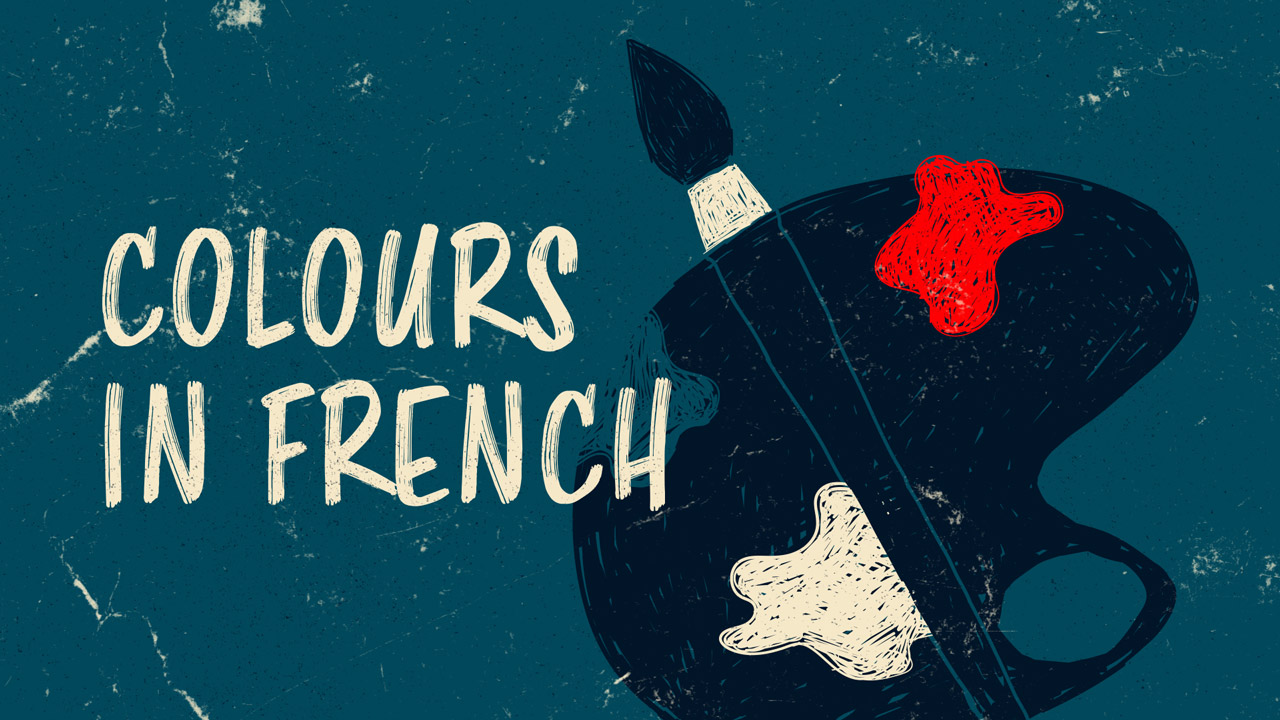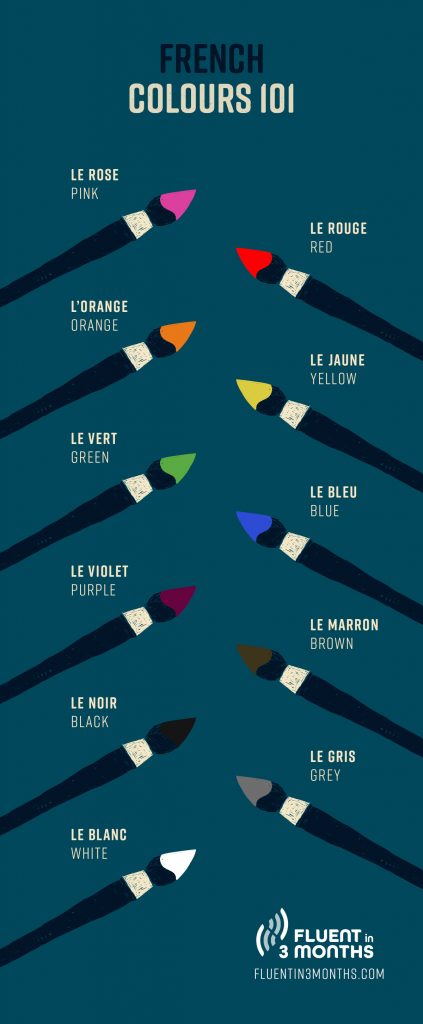27 Colours in French to Brighten Your Day
Are you learning colours in French? You’ve come to the right place!
Colours are one of the most fun and essential topics to cover when you’re learning a new language.
At Fluent in 3 Months (Fi3M) we’ve made it our goal to help learners achieve their goals in their target language, so I want to help you with your colourful mission.
Here’s what we’ll cover:
Table of contents
Grab your crayons and let’s get this multicolore adventure started!
French Colours 101 – Learn the Colour Names in French with this List
“Colour” in French is couleur. It’s a feminine noun, so “the colour” is la couleur and “a colour” is une couleur. “The colours” translates to les couleurs. Oddly enough, the colours themselves are masculine nouns in French. We’ll talk about this more later.
For now, let’s look at a list of the most common colours in French. We’ve included audio for each one to help you work on your pronunciation.
French Colours List:
- – “pink”
- – “red”
- – “orange”
- – “yellow”
- – “green”
- – “blue”
- – “purple”
- – “brown”
- – “black”
- – “grey”
- – “white”
Here’s an infographic you can reference to help you with your studies:
These 11 colors are the ones you’re most likely to run into in everyday French. However, there are many other colours to learn if you want to make your days even more colourful.
Here is a list of extra colours in French:
- – “gold”
- – “silver”
- – “bronze”
- – “lilac”
- – “mauve”
- or – “fuchsia”
- – “burgundy”
- – “fire brick red”
- or – “peach” (la pêche is the fruit)
- – “tan”
- – “turquoise”
- – “navy blue”
- – “sky blue”
- – “indigo”
- – “mint”
Wow! You have enough colours here to make a very bright arc-en-ciel (“rainbow”)! But what if you’re talking about hair colour?
Hair colour in French:
- (masculine) / (feminine) – “blond/e”
- / – “brown” (dark shade)
- – “brown” (chestnut shade)
- / – “red-headed”
How to Modify French Colours
Even if it seems like there are a lot of colours in the lists above, you can learn to describe even more shades with one simple trick.
In French, “shade” is teinte or nuance. To say “a shade of green”, you would say une teinte de vert or une nuance de vert. So what shades of green can you think of? Maybe “olive” or “mint”?
But there are many shades for every basic colour. Learning them all would take a lot of time. Instead, you can describe shades of color with simple adverbs.
Think of how we describe colours in English. We might say “light [green]”, “dark [green]”, “pastel [green]”, “dull [green]”, or “bright [green]”.
You can apply these adverbs to any colour. With only a few words, you’re able to describe several shades! This is useful if you want to learn French faster.
Here are French adverbs you can use to modify colours:
- – “light”
- – “dark”
- – “paster”
- – “bright”
- – “dull”
- – “fluorescent”
Native tip: Remember the word that describes the shade of the colour comes after the colour itself. So while in English we say “light green”, in French you’d say vert clair.(
There’s another common way to modify colours in French, and it involves the suffix -âtre.
When you add -âtre to a colour, it will often carry a negative connotation. For example, if you say that a book’s pages are jaunâtre, it will come across as if you’re saying the book’s pages are unpleasantly yellow.
Can Colours in French Be Feminine?
As you know, French nouns have a gender: they’re either masculine or feminine.
Examples:
- “knife” is masculine → le couteau
- “table” is feminine → la table
As I told you earlier, all colours in French are masculine when they are nouns: le rouge, le vert, le blanc, le rose.
But you might have seen “green” written as verte instead or vert. Or “white” written as blanche instead of blanc. In this case, aren’t verte and blanche the feminine versions of vert and blanc?
The answer is yes. That’s because the French colours can become feminine when they are adjectives.
Gender Agreement Rule in French
Let’s pause here for a second and talk about the gender agreement rule in French. The gender of nouns in French doesn’t only affect what determiner (e.g. le/la) a noun needs. It also affects the form of the adjectives that describe the noun.
For example, if a noun is feminine, the adjective has to be in feminine form, too. You can’t say la table vert, you have to say la table verte.
Native tip: Don’t forget that adjectives don’t go before the noun in French. While in English you’d say “a white cloud”, in French you’d say *un nuage blanc.*
Colours like rouge, rose, marron, jaune, and orange don’t change in feminine form. However, these colours do:
- violet becomes violette
- bleu becomes bleue
- vert becomes verte
- noir becomes noire
- gris becomes grise
- blanc becomes blanche
- doré becomes dorée
- argenté becomes argentée
It’s important to remember that French also has a number agreement rule. This means that you would say la table verte, because table is feminine and singular, and les tables vertes when tables is plural.
There’s an exception with colours and the agreement rules. The colours as adjectives don’t have to adapt to the noun if an adverb describes them. Remember the adverbs like clair and foncé? You can say une table verte but you can’t say une table verte clair. The right way to say it is une table vert clair.
French Colour Verbs
You’ve seen French colours in their noun form and their adjective form. But did you know that there are also colour verbs in French?
In English, you can say that something turns red by using the verb “redden”. There’s also a verb for turning grey, black, and white. There’s no verb for turning yellow, however.
But French has it! Let’s go over French colour verbs together.
French Colour Verbs List:
- – “to blacken”
- – “to grey” (It’s also used figuratively as “to make tipsy”)
- – “to whiten”
- – “to redden”, also “to blush”
- – “to become/turn yellow*
- – “to become/turn blue”
- – “to become/turn green”
- – “to become/turn pink”
- – “to become/turn brown”
There are more French colour verbs, but they’re not very common.
One you might want to learn, however, is grisonner. Its also a way to say “to grey”, but the French use it most often to describe the greying of hair and/or note aging. The verb itself is not as frequently used as the adjective: grisonnant/e.
Examples:
- Je grisonne – “I am greying” or “I am going grey.”
- Il aime ses cheveux grisonnants – “He likes his graying hair.”
I know what you’re thinking now: What if you want to say that something is “turning purple”? There isn’t a verb for that.
Don’t worry, it’s very easy!
The verb “to become” is devenir in French. If you pair devenir with any colour, you will get the same result as if you used the colour verbs!
Examples:
- devenir rouge – “to become/turn red”
- devenir jaune – “to become/turn yellow”
- devenir violet – “to become/turn purple”
Hack time: If you’re a beginner French learner, use this to your advantage. Instead of cramming all the different colour verbs, learn to use devenir* + colour noun. It has the same meaning and makes learning much quicker!*
It’s this type of shortcut that I encourage the Fluent in 3 Months Challenge participants to use. It gives you more room to learn extra vocabulary for the 15-minute conversation you’ll have after only 90 days!
Apply French Colour-Related Vocabulary to Everyday Life
French Colour-Related Expressions
As I told you earlier in the post, colours are popular in everyday French conversation. This is due, in big part, to French idioms!
Colours are used in expressions that range from food, like jaune d’œuf (“egg yolk”) and cordon-bleu (“exceptional cook”), to gardening. Avoir la main verte (literally “to have a green hand”) means to be a very good gardener.
Here are some of the most common French idioms that use colours:
- vert de rage – “durious”, literally “green with rage” (like the Hulk!)
- donner le feu vert à quelqu'un – “to give someone the green light”
- blanc comme un linge – *as white as a sheet”
- de but en blanc – “point blank”, literally “from goal to white”
- avoir carte blanche – “to be granted the ability to do what one wants”, literally “to have white card”
- avoir un bleu – “to have a bruise”, literally “to have a blue”
- une peur bleue – “a stiff scare”, literally “a blue fear”
- rouge comme une tomate – “red as a tomato”
- l'or noir – “oil”, literally “black gold”
- broyer du noir – “to feel down”, literally “to crush black”
- voir la vie en rose – “to see everything through rose-colored glasses”, literally “to see life in pink”
French Colour-Related Questions
Any questions about colour questions? I’ll give you a few options.
If you simply want to ask “What colour?” in French, say Quelle couleur? Be careful, though! This only works if What colour? is a question on its own. It would not work if you want to ask someone what colour something is.
Instead, to say “What colour are your eyes?” in French, say De quelle couleur sont tes yeux? The answer could be ils sont [verts] or simply [verts]. If you’re writing this down, remember the -s at the end of the colour because of the number agreement rule.
The question “What is your favourite colour?” in French is Quelle est ta couleur préférée? You could answer that question in two ways: either by saying c’est le [bleu] (“it’s blue”), or simply, le [bleu] (“blue”).
Have you noticed how the short answers are different for the last two questions? For De quelle couleur sont tes yeux?, the answer is vert. For Quelle est ta couleur préférée?, the answer is le bleu. This is because verts is used as an adjective for “eyes”, and bleu is used as a noun.
You Can Now Talk About a Rainbow of Colours in French!
The more colours life has, the more beautiful it is! And now you’re able to brighten your days with French colours, how cool is that?
If you want to learn all of these colours successfully, you might want to use flashcards. They’re a great way to memorise vocabulary, most of all if they’re colorful and visually engaging!
If you’re learning French, you should check out my tips on how to learn French faster!
Bonne chance! (“Good luck!”)




Social